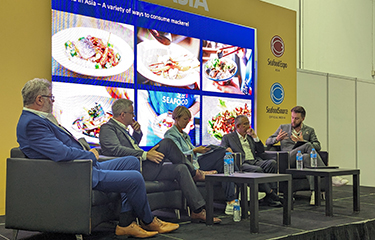As Norway continues to work on expanding its market reach in Asia, representatives of the country's seafood industry have identified a potentially lucrative avenue for increasing sales.
A panel of seafood exports discussed the state of the seafood industry, consumer trends, and industry challenges in Asia during a workshop at Seafood Expo Asia – which ran from 11 to 13 September in Singapore. The panel, which included officials from the Norwegian Seafood Council and members of the Norwegian and Singaporean seafood industries, discussed how current market trends in Asia can be leveraged for future growth.
NSC Analyst Johan Kvalheim said the market for Norwegian salmon in Asia, which makes up the majority of seafood sales by value, is now dominated by China, while just a year ago, when the Japanese market was bigger than both South Korea and China combined.
“There has been a big shift over the last eight months,” Kvalheim said.
The Asian salmon market is also seeing a shifting trend towards fillets versus whole fish, he added. In the Japanese market, for example, 50 percent of all salmon shipments were fillets in the past, but that figure has increased to as much as 78 percent this year.
“The whole fish [demand] is decreasing because we are flying it in. it is better for the value, better for the customers,” Kvalheim said.
A fillet, he said, represents a final product that can be entirely utilized, whereas a whole fish could produce waste products – an expensive proposition for air transit.
“It is better value for the consumers, it is better value for the importers, and it is also better in terms of CO2 emissions, because we are only transporting the product that we are going to eat,” Kvalheim said.
The majority of those salmon products are also being sold via the retail market in Japan, he added. Up to 90 percent of fresh salmon sales go through retail, with just 10 percent going to the HORECA (hotel, restaurant, catering) category.
Another overarching trend in Japan is that seafood consumption is dropping as meat consumption increases. The majority of seafood sold in Japan remains fresh, however, according to Kvalheim.
“The majority is fresh consumption, raw consumption,” Kvalheim said.
For its part, South Korea is experiencing relatively flat seafood consumption, but is also seeing a shift in how seafood is consumed. While the country's consumption is also majority fresh, raw consumption, the amount of heated products being purchased in South Korea is rising.
“They are using it more for heated products, smoked, and also aged products,” Kvalheim said.
That increase could be a potential avenue for Norwegian seafood firms to boost their sales to Asia, according to Kvalheim. Most Asian countries are still primarily sourcing products eaten raw, whereas European consumption is mostly cooked salmon. Touting heated salmon can provide also create a new market for value-added products, which last longer in transit and may not need to be flown directly into Asia.
“For us to get growth in Asia, I strongly believe they should also get moving into the heated category,” Kvalheim said.
Singapore-based The Fish Farmer Founder Malcolm Ong pointed to two other potential means of growing seafood consumption in Asia: cost and convenience.
“When I was a child, salmon was for the elite, but along the way, now salmon has become for the masses,” Ong said. “There’s two things that I see trending, time and money.”
Ong said a convenient product that costs less will usually win out across Asian marketplaces.
Snorre Food CEO and Founder Frank Naesheim said from a marketing perspective, the seafood industry's approach must begin by targeting consumption in restaurants.
“You need to go more through the chefs, I believe, before you can make it in the supermarket,” said Naesheim, who was also the executive chef at the Vikings Restaurant in Singapore before founding his company. “You need to eat it in the restaurants 10 to 20 times before you go to the supermarket and then make it at home.”
Photo by Chris Chase/SeafoodSource







